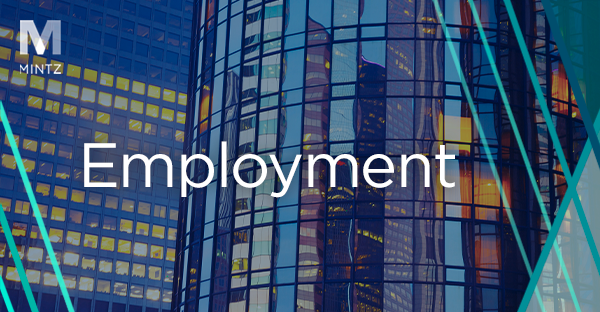
Employment
Viewpoints
Filter by:
Prepping for Sale: Getting Your Employment and Benefits House in Order
November 25, 2025 | Blog | By Michelle Capezza, Alexander Song, Joseph J. Ronca
Preparing for the sale of a company can often be overwhelming, leaving sellers and company management scrambling as they approach closing. This post highlights key employment and benefits considerations to address in preparation for a sale, offering practical insights to help sellers and company management navigate the sale with confidence and efficiency. Taking these preliminary steps and anticipating buyer diligence questions can help companies present a well-managed organization, streamline the diligence process, and accelerate deal execution.
Hiring Across the 49th Parallel: Traps for the Unwary for Cross-Border US-Canada Hires (Part III)
November 24, 2025 | Blog | By Brad Tartick, Geri Haight, Anthony de Fazekas, Patrick Denroche
In today’s competitive market, safeguarding intellectual property (IP) and managing employment risks are critical for businesses operating in Canada and the United States. From onboarding to departure, employers must safeguard their interests and manage restrictive covenants in an evolving legal landscape. In this Part III of our cross-border series, we discuss practical strategies to mitigate risk and protect your organization throughout the employee lifecycle.
Mintz On Air: Practical Policies — Accommodating Stress at Work: Legal Insights and Practical Strategies for Employers
November 18, 2025 | Podcast | By Jennifer Rubin, Yeilee Woo
The latest Mintz on Air: Practical Policies podcast explores stress-related accommodation requests, legal frameworks, and practical strategies for employers. Listen now.
Employers Should Revisit Their Non-Compete Agreements after Latest Massachusetts Superior Court Ruling
November 10, 2025 | Article | By Savannah M. Wormley, Natalie C. Groot, Benjamin Ferrucci, Andrew Matzkin
A recent decision from the Massachusetts Superior Court has put “employers” on notice. In Anaplan Parent LP and Anaplan Inc. v. Timothy Brennan, the court interpreted the term “employer” under the Massachusetts Non-Competition Agreement Act (“MNAA”) narrowly in refusing to enforce non-competition provisions set forth in three equity agreements an employee signed with the parent company of his employing entity, but not the employing entity itself.
Employers who broadly use restrictive covenants across multiple employment and other documents should carefully review the decision and consider whether they need to address their existing restrictive covenant scheme to ensure enforceability under the MNAA.
NYC Employers Face New Obligations As City Council Changes Sick/Safe Leave and Pay Data Reporting Requirements
November 5, 2025 | Blog | By Kayla Lucia, Corbin Carter, Michael Arnold
New York City employers should heed two important new legislative developments coming out of City Council.
First, the City amended its Earned Sick and Safe Time Act (ESSTA) and its Temporary Schedule Change Act (“TSCA”) to establish a new unpaid leave requirement in addition to existing paid leave requirements and to expand the permissible uses for employee sick/safe leave (among other changes, as discussed below). These changes will take effect on February 22, 2026.
California Bans Employee “Stay or Pay” Contracts
November 4, 2025 | Blog | By McKenzie Rugo, Jennifer Rubin
In further support of California’s longstanding opposition to employee mobility restrictions, on October 13, 2025, Governor Gavin Newsom approved a measure targeting “Stay or Pay” contracts that seek employee financial repayment tied to employment terminations. The final bill was originally intended to capture training repayment agreement provisions but bans broader stay or pay contracts. Employers should carefully review the new law, eliminate any banned arrangements, and modify those that are exempted (but subject to the law’s strict exemption requirements). We discuss the new law in more detail below.
Newsom Nixes No Robo Bosses Act
October 16, 2025 | Blog | By Jennifer Rubin, Evan Piercey
As we previously reported, on September 19, 2025, the California legislature sent SB 7, the “No Robo Bosses Act” to Governor Newsom for signature. On October 13, 2025, Governor Newsome vetoed the Act, explaining in a press release that while he shared concerns about the use of AI by employers, the bill “proposes overly broad restrictions on how employers may use [automated decision systems] tools.”
Massachusetts Pay Transparency Law: Key Updates Regarding Job Posting Requirements Effective October 29, 2025
September 30, 2025 | Blog | By Natalie C. Groot, Tom J. Pagliarini
As we approach the October 29, 2025 effective date for employers to ensure compliance with Massachusetts’s new pay transparency law, An Act Relative to Salary Range Transparency (the “Act”), we write to highlight the guidance that the Office of the Attorney General published since our most recent update here.
Mintz On Air: Practical Policies — Real Versus Robot: The Benefits of AI-Assisted Mediations
September 30, 2025 | Podcast | By Jennifer Rubin
Jen Rubin, Judge Feffer & Curtis Holdsworth explore AI-assisted mediation, legal ethics, and cost-saving strategies in this Mintz On Air podcast episode.
California Passes “No Robo Bosses” Act – With October 12 Deadline for Governor Action
September 19, 2025 | Blog | By Jennifer Rubin, Evan Piercey
On September 12, 2025, California lawmakers took a significant step forward in regulating the use of artificial intelligence (“AI”) in the workplace by passing SB 7, a bill aptly referred to as the “No Robo Bosses” Act. If Governor Newsom signs the bill into law—a decision he must make by September 30, 2025—SB 7 would take effect on January 1, 2026 and would have an immediate impact on the use of AI in the workplace, including prohibiting employers from relying solely on AI to make decisions regarding employee discipline or termination. Below, we highlight the most salient aspects of SB 7 and make some recommendations for employers going forward, if Governor Newsom signs the bill into law.
Refresher on MAPFML Requirements in Advance of Private Plan Updates
September 18, 2025 | Blog | By Natalie C. Groot, Emma Follansbee
It’s that time of year again. Employers that meet the requirements of Massachusetts Paid Family and Medical Leave (“MAPFML”) law through a self-insured or third-party private plan administrator are required to renew their private plans for approval by the Massachusetts Department of Paid Family and Medical Leave (the “Department”). Approved exemptions are renewed on an annual basis, and the process begins during the quarter prior to the expiration of an employer’s current exemption (e.g., if an employer’s private plan exemption year begins on October 1, they must submit for renewal approval on or before September 30).
Mintz On Air: Practical Policies – DEI Developments: The Proxy Problem
September 16, 2025 | Podcast | By Jennifer Rubin, Nicole Rivers
Jen Rubin and Nikki Rivers unpack DEI legal risks, proxy bias, and compliance strategies in this episode of Mintz On Air: Practical Policies.
Mintz On Air: Practical Policies – Disparage Me Not
August 26, 2025 | Podcast | By Jennifer Rubin, Natalie C. Groot
Host Jen Rubin is joined by Member Natalie Groot for a practical conversation on non-disparagement clauses. This episode is part of a series of conversations designed to help employers navigate workplace changes and understand general legal considerations.
Mintz On Air: Practical Policies - Investigations Unscripted
August 12, 2025 | Podcast | By Jennifer Rubin, Natashia Tidwell
Member Jen Rubin is joined by Member Natashia Tidwell for an unscripted conversation about conducting effective workplace investigations.
The DOJ Issues Its Interpretation of “Illegal DEI”
August 1, 2025 | Blog | By Michael Arnold, Jennifer Rubin, Nicole Rivers, Kayla Lucia
The U.S. Department of Justice issued a memorandum to all Federal Agencies providing guidance clarifying the application of Federal discrimination law to DEI programs and offering best practices for program compliance. The memorandum, Guidance for Recipients of Federal Funding Regarding Unlawful Discrimination (the “Guidance”), ostensibly focused on entities receiving federal funding, fleshes out what the Trump Administration meant when it referred to “illegal DEI” in a series of Executive Orders issued earlier this year, and is far more expansive than the guidance the EEOC/DOJ jointly issued back in March (which we discussed here). While the DOJ confirmed that the Guidance is non-binding (e.g. the best practices it offers are not mandatory), employers, whether they do business with the federal government or not, should pay very close attention to its overall message. We summarize the guidance below.
New York COVID-19 Paid Sick Leave Expires
August 1, 2025 | Blog | By Michael Arnold, Corbin Carter, Kayla Lucia
More than 5 years from the onset of the COVID-19 pandemic, New York’s COVID-19 paid sick leave law has now officially expired as of July 31, 2025. The COVID-19 paid sick leave law, which was enacted during pandemic-related lockdowns in March 2020, had required most New York employers to provide paid, job-protected COVID-19 sick leave to employees who were under a mandatory or precautionary order of quarantine or isolation due to COVID-19 (or who were caring for family members who were under such orders). Although COVID-19 unfortunately remains a reality, the pandemic phase (and related employee leave protections) have now come and gone.
NYC Sick Leave Law Amendments Prompt New Employer Obligations
July 30, 2025 | Blog | By Michael Arnold, Corbin Carter, Kayla Lucia
Recent amendments to New York City’s Earned Sick and Safe Time Act (ESSTA) went into effect this month. Consistent with recent amendments to New York State law (which we discussed here and here), the City’s amended leave law now explicitly requires NYC employers to provide up to 20 hours of paid prenatal leave for eligible employees within a 52-week period and seeks to integrate related paid prenatal leave obligations into the existing ESSTA compliance framework for safe/sick time. The amendments also clarify the available penalties, remedies, and enforcement mechanisms for violations of the paid prenatal leave requirements.
Massachusetts Paid Family and Medical Leave—Updates from the Department
July 23, 2025 | Blog | By Natalie C. Groot, Tara Dunn Jackson
The Massachusetts Department of Family and Medical Leave (the “Department”) recently updated its Employer Portal, issued a reminder for the private plan reporting deadline of August 31, 2025 and summarized tax guidance concerning the Massachusetts Paid Family and Medical Leave law. We explore each of these updates in more detail.
409A Risks with Relocation Reimbursements
July 22, 2025 | Blog | By Alexander Song, Dana Sebrow
Reimbursements for relocation expenses have once again become a key component of attracting top talent. If not carefully structured, however, such expense reimbursements may inadvertently trigger significant adverse tax consequences under Section 409A of the Internal Revenue Code. This post discusses some of the requirements under Section 409A and offers tips for avoiding some of the common pitfalls in drafting relocation benefits.
Navigating Massachusetts Taxes after Relocation: Key Takeaways from Welch v. Commissioner of Revenue
July 17, 2025 | Blog | By Dana Sebrow, Tom J. Pagliarini, Quinn Hetrick, Benjamin Ferrucci
Many Massachusetts residents have recently considered taking, or have undertaken, steps to relocate from Massachusetts to jurisdictions with lower or no state income taxes, especially in light of the recently enacted 2023 Massachusetts “Millionaire’s Tax”. While such a move could offer significant tax advantages, a recent Massachusetts Appeals Court decision, Welch v. Commissioner of Revenue, could reshape how nonresidents are taxed on capital gains from stock sales, emphasizing where the value was earned over where it is recognized.
Explore Other Viewpoints:
- Data Centers & Digital Infrastructure
- AI: The Washington Report
- Antitrust and Federal Regulation
- Appellate
- Arbitration, Mediation & Alternate Dispute Resolution
- Artificial Intelligence
- Awards
- Bankruptcy & Restructuring
- California Land Use
- Cannabis
- Class Action
- Complex Commercial Litigation
- Construction
- Consumer Product Safety
- Corporate Governance (ESG)
- Cross-Border Asset Recovery
- DEI Legal Developments
- Debt Financing
- Direct Investing (M&A)
- Diversity
- EB-5 Financing
- Education & Nonprofits
- Employment
- EnforceMintz
- Environmental (ESG)
- Environmental Enforcement Defense
- Environmental Law
- Environmental, Social, and Corporate Governance (ESG)
- FDA Regulatory
- False Claims Act
- Federal Circuit Appeals
- Financial Institution Litigation
- Government Law
- Growth Equity
- Health Care
- Health Care Compliance, Fraud and Abuse, & Regulatory Counseling
- Health Care Enforcement & Investigations
- Health Care Transactions
- Health Information Privacy & Security
- IP Due Diligence
- IPRs & Other Post Grant Proceedings
- Immigration
- Impacts of a New US Administration
- Insolvency & Creditor Rights Litigation
- Institutional Investor Class Action Recovery
- Insurance & Financial Services
- Insurance Consulting & Risk Management
- Insurance and Reinsurance Problem-Solving & Dispute Resolution
- Intellectual Property
- Investment Funds
- Israel
- Licensing & Technology Transactions
- Life Sciences
- Litigation & Investigations
- M&A Litigation
- ML Strategies
- Managed Care
- Medicare, Medicaid and Commercial Coverage & Reimbursement
- Mergers & Acquisitions
- Patent Litigation
- Patent Prosecution & Strategic Counseling
- Pharmacy Benefits and PBM Contracting
- Portfolio Companies
- Privacy & Cybersecurity
- Private Client
- Private Equity
- Pro Bono
- Probate & Fiduciary Litigation
- Products Liability & Complex Tort
- Projects & Infrastructure
- Public Finance
- Real Estate Litigation
- Real Estate Transactions
- Real Estate, Construction & Infrastructure
- Retail & Consumer Products
- Securities & Capital Markets
- Securities Litigation
- Social (ESG)
- Special Purpose Acquisition Company (SPACs)
- Sports & Entertainment
- State Attorneys General
- Strategic IP Monetization & Licensing
- Sustainable Energy & Infrastructure
- Tax
- Technology
- Technology, Communications & Media
- Technology, Communications & Media Litigation
- Trade Secrets
- Trademark & Copyright
- Trademark Litigation
- Unified Patent Court (UPC)
- Value-Based Care
- Venture Capital & Emerging Companies
- White Collar Defense & Government Investigations
- Women's Health and Technology





